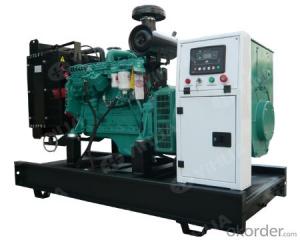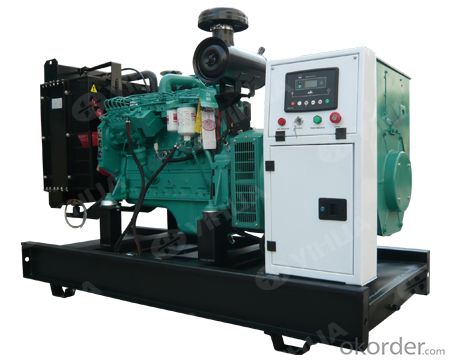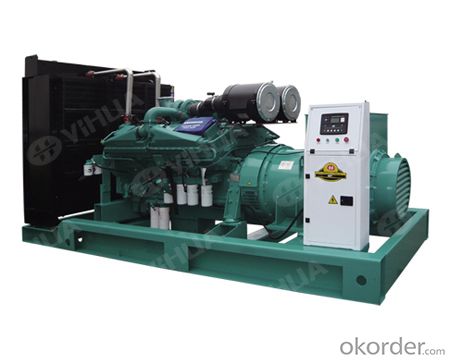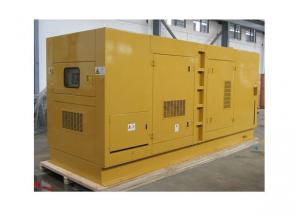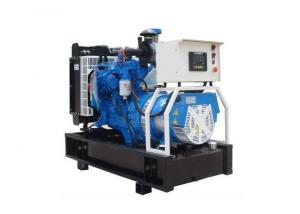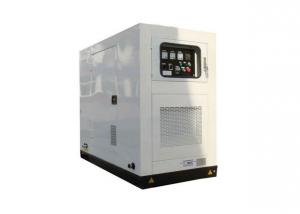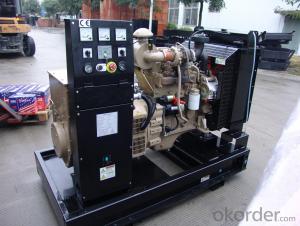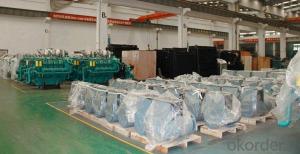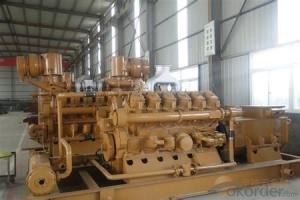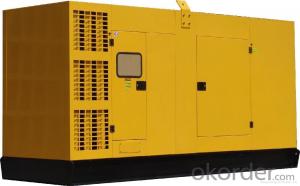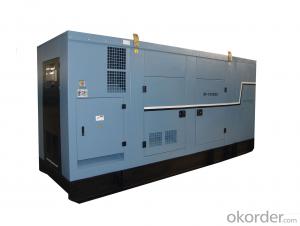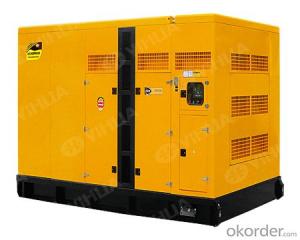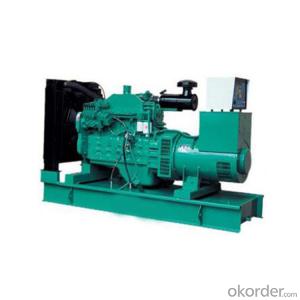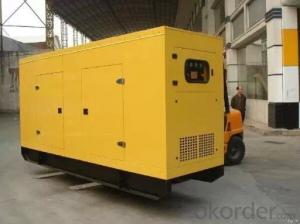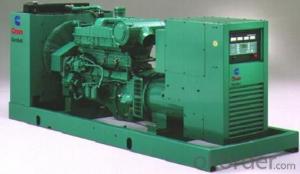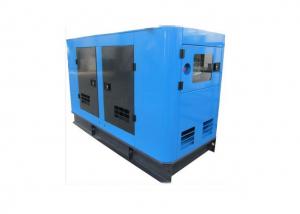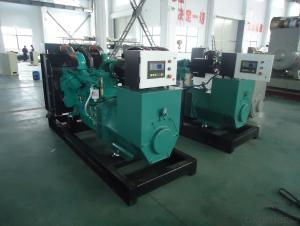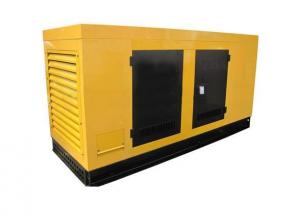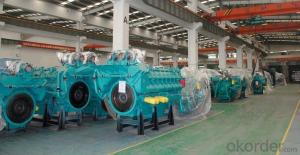Cummins 20-300KW Open Type Diesel Generator Set
- Loading Port:
- Fuzhou
- Payment Terms:
- TT OR LC
- Min Order Qty:
- -
- Supply Capability:
- 500-700 unit/month
OKorder Service Pledge
OKorder Financial Service
You Might Also Like
Cummins 20-200 KW Open Type Diesel Generator Set
Technical Date
YIHUA- DCEC CUMMINS series diesel generator power coverage from 16kw~220kw 。
Adopting DCEC Cummins, it's manufacturing base invested by Cummins in China, who is specializing in low or medium power diesel engine .The prime products are 4B,6B,6C,6L series diesel engine Gen-set. with globally uniform quality standard, compact structure ,reliable capability, high ly durability, safety and emission.
Power coverage from 16kw~200kw
Model: GF: Open type &GFS: Soundproof /Silent/Supper silent type
Engine: DCEC Cummins
Speed: 1500/1800rpm
Alternator: Stamford /Leroysomer /Marathon/ABB/YIHUA YHG
IP &Insulation Class: IP22-23 &F/H
Frequency: 50/60HZ
Controller: Deepsea/Comap/Smartgen/DKG/Others
ATS System: Smartgen/ABB/SOCOMIC /Others
Silent&Supper silent Gen-set Sound level: 63-75db(at 7m side)
Generator set Techinical specification | ||||||||||||
generator set performance | Engine performance | Dim.L*W*H | ||||||||||
Genset model | Prime power | Standby power | Fre. | Model | Power | Full load | Open type | Weight | ||||
KW | KVA | KW | KVA | HZ | KW | (L) | (mm) | (kg) | ||||
GF/GFS-C16KW | 16 | 20 | 26 | 32.5 | 50 | 4B3.9-G1/G2 | 24 | 5 | 1700*750*1150 | 850 | ||
GF/GFS-C20KW | 20 | 25 | 26 | 32.5 | 50 | 4B3.9-G1/G2 | 24 | 6 | 1700*750*1150 | 850 | ||
GF/GFS-C30KW | 30 | 37.5 | 33 | 41.3 | 50 | 4BT3.9-G1/G2 | 36 | 8 | 1820*760*1150 | 900 | ||
GF/GFS-C34KW | 34 | 42.5 | 37.4 | 46.8 | 50 | 4BT3.9-G1/G2 | 36 | 8 | 1820*760*1150 | 950 | ||
GF/GFS-C40KW | 40 | 50 | 44 | 55 | 50 | 4BTA3.9-G2 | 50 | 9.8 | 1950*830*1150 | 1050 | ||
GF/GFS-C45KW | 45 | 56.25 | 49.5 | 61.9 | 50 | 4BTA3.9-G2 | 50 | 13 | 1950*830*1150 | 1070 | ||
GF/GFS-C58KW | 58 | 72.5 | 63.8 | 79.8 | 50 | 6BT5.9-G1/G2 | 86-92 | 23 | 2150*880*1350 | 1120 | ||
GF/GFS-C68KW | 68 | 85 | 74.8 | 93.6 | 50 | 6BT5.9-G1/G2 | 86-92 | 23 | 2150*880*1350 | 1120 | ||
GF/GFS-C80KW | 80 | 100 | 88 | 110 | 50 | 6BT5.9-G1/G2 | 86-92 | 23 | 2150*880*1400 | 1120 | ||
GF/GFS-C90KW | 91 | 113.75 | 100.1 | 125.1 | 50 | 6BTA5.9-G2 | 110 | 23 | 2350*950*1360 | 1200 | ||
GF/GFS-C100KW | 100 | 125 | 110 | 137.5 | 50 | 6BTA5.9-G2 | 110 | 23 | 2350*950*1360 | 1235 | ||
GF/GFS-C110KW | 110 | 137.5 | 121 | 151.3 | 50 | 6BTAA5.9-G2 | 120 | 26 | 2350*950*1360 | 1400 | ||
GF/GFS-C128KW | 128 | 160 | 140.8 | 176 | 50 | 6CTA5.9-G2 | 163 | 33.9 | 2470*950*1430 | 1900 | ||
GF/GFS-C144KW | 144 | 180 | 158.4 | 198 | 50 | 6CTA5.9-G2 | 163 | 35.1 | 2470*950*1430 | 1900 | ||
GF/GFS-C150KW | 150 | 187.5 | 165 | 206.3 | 50 | 6CTA5.9-G2 | 163 | 35.1 | 2470*950*1430 | 2000 | ||
GF/GFS-C160KW | 160 | 200 | 176 | 220 | 50 | 6CTAA5.9-G2 | 183 | 38.7 | 2600*980*1450 | 2300 | ||
GF/GFS-C180KW | 180 | 225 | 198 | 247.5 | 50 | 6LTAA8.9-G2 | 220 | 38.7 | 2600*1000*1450 | 2400 | ||
GF/GFS-C200KW | 200 | 250 | 220 | 275 | 50 | 6LTAA8.9-G2 | 220 | 41.6 | 2600*1000*1500 | 2500 | ||
GF/GFS-C20KW | 20 | 25 | 26 | 32.5 | 60 | 4B3.9-G1/G2 | 27 | 5 | 1700*750*1230 | 850 | ||
GF/GFS-C22KW | 22 | 27.5 | 26 | 32.5 | 60 | 4B3.9-G1/G2 | 27 | 6 | 1700*750*1230 | 850 | ||
GF/GFS-C30KW | 30 | 37.5 | 33 | 41.3 | 60 | 4BT3.9-G1/G2 | 40 | 8 | 1820*760*1240 | 900 | ||
GF/GFS-C34KW | 34 | 42.5 | 37.4 | 46.8 | 60 | 4BT3.9-G1/G2 | 40 | 8 | 1820*760*1240 | 950 | ||
GF/GFS-C48KW | 48 | 60 | 52.8 | 66 | 60 | 4BTA3.9-G2 | 60 | 9.8 | 1950*830*1270 | 1050 | ||
GF/GFS-C55KW | 55 | 68.75 | 60.5 | 75.6 | 60 | 4BTA3.9-G2 | 60 | 13 | 1950*830*1270 | 1070 | ||
GF/GFS-C68KW | 68 | 85 | 74.8 | 93.5 | 60 | 6BT5.9-G1/G2 | 92-102 | 23 | 2150*880*1400 | 1120 | ||
GF/GFS-C80KW | 80 | 100 | 88 | 110 | 60 | 6BT5.9-G1/G2 | 92-102 | 23 | 2150*880*1400 | 1120 | ||
GF/GFS-C90KW | 90 | 112.5 | 99 | 123.8 | 60 | 6BT5.9-G1/G2 | 92-102 | 23 | 2150*880*1400 | 1120 | ||
GF/GFS-C100KW | 100 | 125 | 110 | 137.5 | 60 | 6BTA5.9-G2 | 120 | 23 | 2350*950*1360 | 1200 | ||
GF/GFS-C110KW | 110 | 137.5 | 121 | 151.3 | 60 | 6BTA5.9-G2 | 120 | 23 | 2350*950*1360 | 1235 | ||
GF/GFS-C120KW | 120 | 150 | 132 | 165 | 60 | 6BTAA5.9-G2 | 132 | 26 | 2350*950*1360 | 1400 | ||
GF/GFS-C144KW | 144 | 180 | 158.4 | 198 | 60 | 6CTA5.9-G2 | 180 | 33.9 | 2470*950*1430 | 1900 | ||
GF/GFS-C150KW | 150 | 187.5 | 165 | 206.3 | 60 | 6CTA5.9-G2 | 180 | 35.1 | 2470*950*1430 | 1900 | ||
GF/GFS-C160KW | 160 | 200 | 176 | 220 | 60 | 6CTA5.9-G2 | 180 | 35.1 | 2470*950*1430 | 2000 | ||
GF/GFS-C180KW | 180 | 225 | 198 | 247.5 | 60 | 6CTAA5.9-G2 | 201 | 38.7 | 2600*980*1450 | 2300 | ||
GF/GFS-C200KW | 200 | 250 | 220 | 275 | 60 | 6LTAA8.9-G2 | 240 | 38.7 | 2600*1000*1450 | 2400 | ||
GF/GFS-C220KW | 220 | 275 | 242 | 302.5 | 60 | 6LTAA8.9-G2 | 240 | 38.7 | 2600*1000*1500 | 2500 | ||
FAQ
1.Q: What is your MOQ of this item?
A: 1-10 piece
2.Q: What is the lead time?
A: 25-35 days after receiving your L/C or T/T deposit.
3.Q: Is it all right to make customer's own brand name?
A: We can be your OEM manufacture with your authorization of brand.
4.Q: Where is your Loading Port?
A: China Port.
5.Q: What are your payment terms?
A: 30% deposit and balance T/T against copy of Bill of Lading or L/C at sight.
6.Q: What is your company's available production capacity?
A: 3000-5000 pieces against your orders.
- Q: I want to ask that how much fuel does a diesel generator consume in one hour?How can I calculate the fuel consumption?
- it consume 10litre
- Q: can DG's be used as a backup for single phase and three phase ac?
- Of course diesel-fueled engine generators can be used a backup, i.e. standby or emergency power. They can also be used as prime power (on all the time). If you need to supply a single phase load, either use a single phase generator (only available for small loads), or use a larger three-phase generator and make sure it has a Y-grounded connection. Even better, get an electrician or electrical engineer to choose the right device for your system.
- Q: Basically, I want to set up the new homestead off grid and would like to do it with a diesel generator to a DC disconnect, to a charge controller, to a battery bank, to the system meter, to the main DC disconnect, to an inverter, then to an AC breaker panel. Just like a solar array system but using the diesel instead of panels for the first year or two. The home will be using no more than about 22kWH daily. I guess the main question is how do I use a diesel generator in place of 19, 210W solar panels without running the generator 24-7?
- It will work if you can do without a few major items. Air conditioning is the main culprit. It uses a huge amount of electricity and amperage. An electric cloths dryer is also a major electricity user, as is an electric stove. Both of the latter can be eliminated if you have natural gas or propane. If your building the house, you can wire the lighting for DC and eliminate some of the inverter task. Inverters are expensive. If you decide to go battery, get industrial forklift batteries. They will hold power longer and give a cleaner flow of electricity than a bank of car batteries. Be sure to used distilled water. It will extend the life of the batteries.
- Q: For anyone well up on EMD E and F units: saw a rather frightful picture last night of an F unit slamming into a switcher. not pretty ofcourse. it was on a curve so the F unit fell to her side to the outside of the curve. but not before breaking in half right behind the cab. the picture caption remarked that this was a common feature of the Es and Fs. By design? for safety? or design flaw? first time id seen this type of damage to an F, and certainly have never heard this comment of them. can someone clarify please? Couple days ago i was doing some reminiscing of railfanning way back in the day. i was fondly thinking of the great time i had with the crews. got to thinking about more of the details. all the stuff they had shown me. then something popped into my head. torpedoes! back then, scary lil devices to me! but rightlyfully so. so while im here in questions, are track torpedoes still used (when needed)? are they still around? havent seen one in quite along time since ive thought about it.thank you!
- I seem to recall a reference in Trains stating that these were designed to buckle right behind the cab in order to protect the crew in cases of head-on collisions. Apparently, the buckling was intended to absorb energy that otherwise might crush the cab. I can see how the buckling might appear to be a design flaw in the form of a weakness in the frame that allows the buckling. But my understanding is that it was an intentional design feature, kind of like how a fuse is the weakest link for the purpose of protecting the rest of the circuit.
- Q: I need a means of driving a 3 horsepower induction motor re-purposed as an induction generator which would coincide with specific cost-effective parameters. I ran the numbers in an excel spreadsheet and realized that the amount of gasoline or diesel required to run an engine appropriate for a 3 horsepower generator consumes more fuel per hour than is economical when the electricity is sold back on the grid. Over a month period, here's what I calculated:Run time in Hrs: 300.00 (10hrs a day, 30 days)Gallons per hour: .30 (1/3rd gallon per hour avg. consumption for 5hp engine)AVG output KW: 2.00 (3 horsepower generator)Fuel in gallons: 90.00 Price of fuel $/gal: 3.50Kilowatt-Hrs: 600.00Energy Cost: .08Net Profit: -270.00I've considered using a pressure cooker, wood pellet stove, and compressor pump as steam engine for an economical way to produce long-term torque, but am not sure how to modify the pump to operate as a steam engine. Anyone have any ideas? Thanks
- Synchronizing an induction generator to the grid is a major problem. Forget it.
- Q: Every time i go to the pawn shop i always end up craping my pants. I crap em so hard that i got to leave to change and come right backnext time i best bring a diaper because the pawn shop always does it to me. Everything is pretty much stolen and new so i get 50% off pawn price because they know me for years.The last time i craped my pants was when i got this really nice 2000$ diesel generator for 400$ and BAM!Didn't even feel it coming, reached in my pocket to count my cash and the next thing i knew was i got a landslide running down my leg filling up my work boot. I bought it there and then anyways with crap on my leg because it was too good a deal to let some other guy steal it, that's my job!I do it at home on the computer sometimes when i'm looking at tools on harborfreight. It never happens with anything else, why only tools?
- It's your butt having an orgasm! Soo cool huh?
- Q: Hi everybody. well I buyed a welding machine, and I need a portable generator for use the welding machine, but I dont know the generator capacity to use it, if the welding machine is 50 to 250 amps, but I just use from 100 to 200 amps, Can I use a 6000 watss Generator? or I need more power?
- About 15KW is needed to run a welder. Preferable is a diesel drive unit. Read the label plate on the welder, it will give the maximum draw needed for the supply side. Double that for the generator rating needed.
- Q: I am doing this project to find eco friendly alternatives for businesses. So how is electricity in it generated. Also.why is the pollution of water bad? I mean i realize that it kills marine life, and it affects biodiversity, but how does it affect the wold, or even us humans???
- Many modern cruise ships use a combination gas and steam power or COGAS plant to produce electric power. Much like you cars alternator in your car it converts other power sources into electricity. Unlike you car though the COGAS system does not directly power the ship but sends the electricity to electric turbines for propulsion and also provides the rest of the ship with electric power. The human body uses about 10 cups of water each day. No matter how it regains this water ( liquid or solid ) all these sources get it from nature. Contaminates in the water, though most tend to be filtered out, pass on to the food or water source that you get it from. Obviously, contaminates like weed killer use on a lawn, can contaminate rivers and streams causing other plants and animals to mutate and die. Though much has been done to keep contaminated water from reaching humans in more recent times some still make it through the filtering systems. Contaminated water has been found to be main contributing factors in plagues, cancer, mutations, as well as other things in humans. I hope this helps.
- Q: If a 13L big diesel engine can produce 400 hp at 1800 rpm, and a 7L diesel can produce 400 hp at 3600 rpm, but the 13L produces twice the torque, which would produce more electricity?
- The 13L would produce more electricity.The smaller generator has to work almost twice as hard to do the same job. Torque is a measure of the turning force on an object such as a bolt or a flywheel. For example, pushing or pulling the handle of a wrench connected to a nut or bolt produces a torque (turning force) that loosens or tightens the nut or bolt. Also the higher the RPM the hard the generator has to work to get to 400hp so your 13L at 3600 RPM would produce around 750 Hp
- Q: Hello, I am putting an HHO generator, which is metal plates in water in pvc pipe, into my small pickup truck. I am having a bit of trouble finding an EFIE unit though, which is the boy that goes in line in front of the 02 sensor, to give it a bit more juice and stop it from dumping more gas in when it thinks there is not enough air (but way too much HHO) in the system.Are there any automotive forums that you all would direct me to? And if not, are there any manufacturers of finished EFIE units, or even kits to build them, on the internet or elsewhere for me to utilize?I want to get this done before I leave for college. Gas prices suck!
- Be very about a leak as it is very dangerous. H will leak through most hoses. U should also a back fire pot to prevent a back fire from fireing into your tank.
Send your message to us
Cummins 20-300KW Open Type Diesel Generator Set
- Loading Port:
- Fuzhou
- Payment Terms:
- TT OR LC
- Min Order Qty:
- -
- Supply Capability:
- 500-700 unit/month
OKorder Service Pledge
OKorder Financial Service
Similar products
Hot products
Hot Searches
Related keywords
